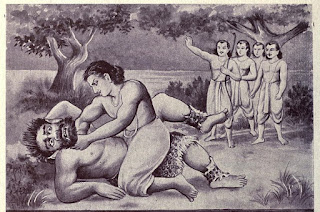Week 7 Story: The Monkey and the Crocodile

Author's Note: This story is a recreation of a famous Jakata, called The Crocodile and the Monkey's Heart , from Eastern Stories and Legends by M. L. Shedlock, which tells of an attempt to deceit the monkey by the crocodile to take his heart and eat it, but of course, the monkey outwits him and escapes the wrath of the crocodile. In this recreation, I told it specifically in the Monkey's point of view, including his initial thoughts as when the Crocodile offered him the proposal of better fruits on the other side of the Ganges River. To make it more relatable, I told it in a more contemporary tone with modern and simple syntax, much like two ordinary people having conversation with one another in modern times! As many of you may, I was a Bodhisatta in a past life, and with this life, I have reincarnated in a form of a monkey. I lived my day to day life as a monkey, making the most of my day. I had the proper education and grew up big and strong, just as my father wanted m...











